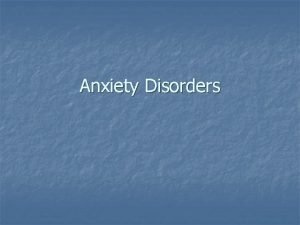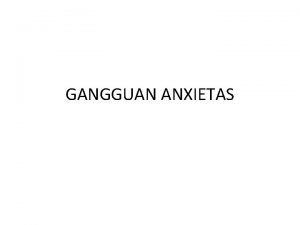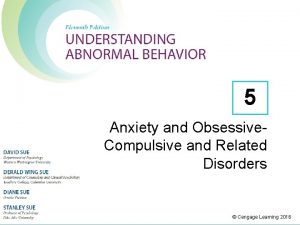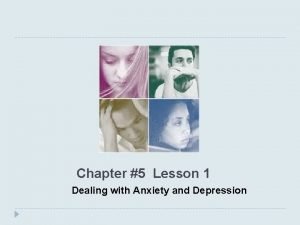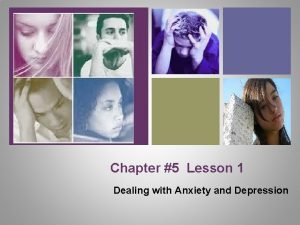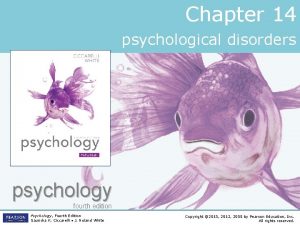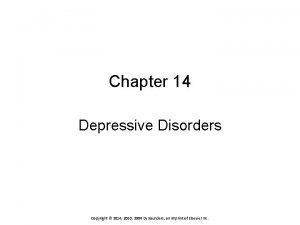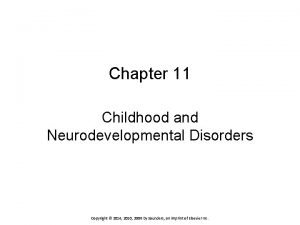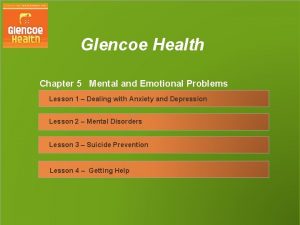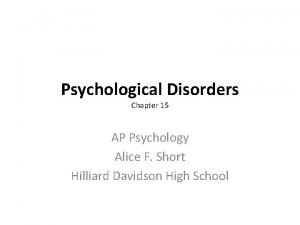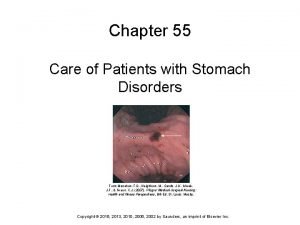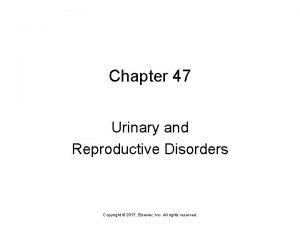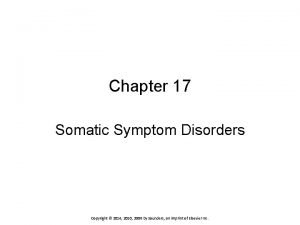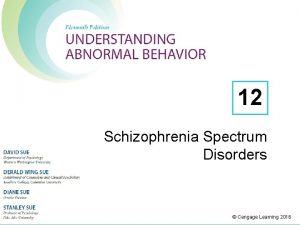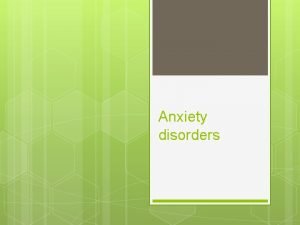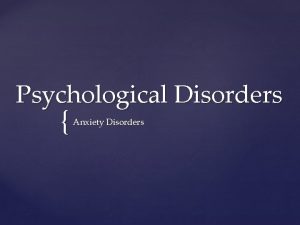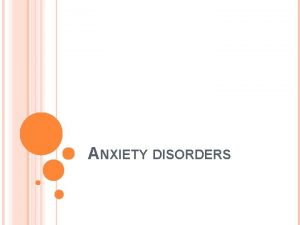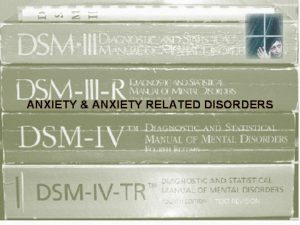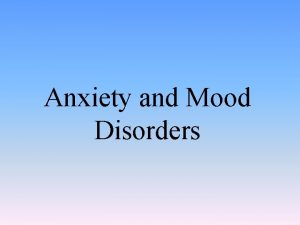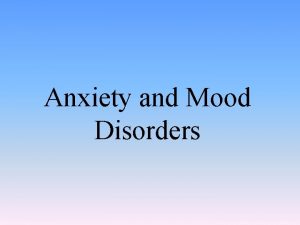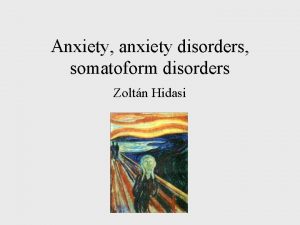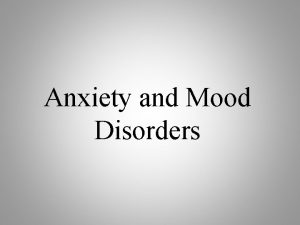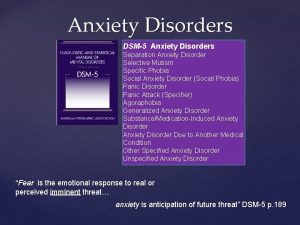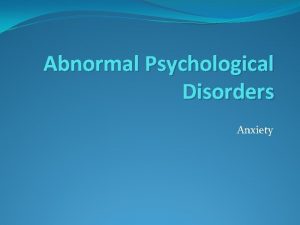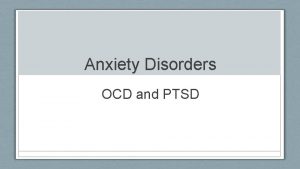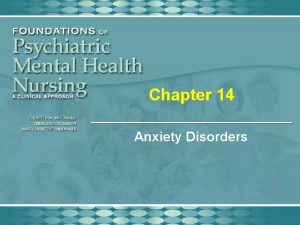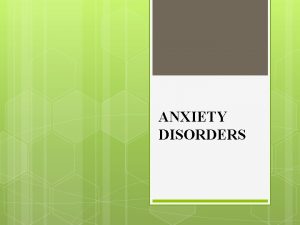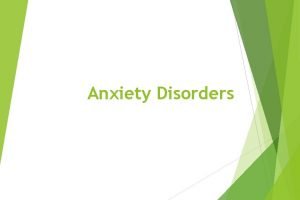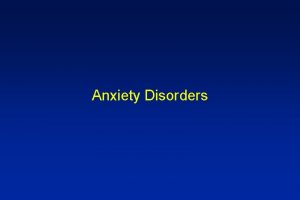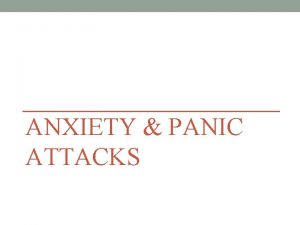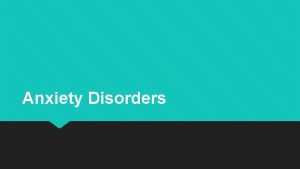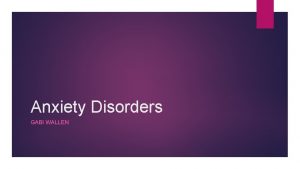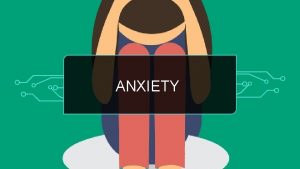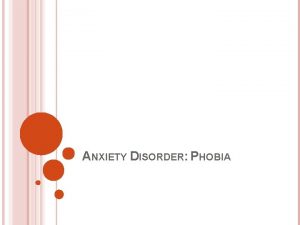Chapter 4 Anxiety Disorders The Complexity of Anxiety

























































- Slides: 57

Chapter 4 Anxiety Disorders

The Complexity of Anxiety Disorders • Anxiety – the future-oriented mood state – Apprehension about future danger or misfortune – Somatic symptoms of tension – Characterized by marked negative affect • Anxiety and fear are normal emotional states

The Complexity of Anxiety Disorders • Fear – the present-oriented mood state – Immediate fight or flight response to danger or threat – Involves abrupt activation of the sympathetic nervous system – Strong avoidance/escapist tendencies – Marked negative affect

From Normal to Disordered Anxiety and Fear • Characteristics of anxiety disorders – Pervasive and persistent symptoms of anxiety and fear – Involve excessive avoidance and escape – Cause clinically significant distress and impairment

The Phenomenology of Panic Attacks • What is a panic attack? – Abrupt experience of intense fear or discomfort – Several physical symptoms (e. g. , breathlessness, chest pain) – Fear as an alarm response

The Phenomenology of Panic Attacks • DSM-IV-TR subtypes of panic attacks – Situationally bound (cued) – Unexpected (uncued) – Situationally predisposed • Cultural influences on anxiety


Biological Contributions to Anxiety and Panic • Genetic vulnerability • Anxiety and brain circuits – Depleted levels of GABA

Biological Contributions to Anxiety and Panic (continued) • Limbic (amygdala) and the septal-hippocampal systems • Behavioral inhibition system (BIS) – Anxiety • Fight/flight system (FF) – Fear

Psychological Contributions to Anxiety and Fear • Integrated model – Early childhood - Experiences with uncontrollability and unpredictability

Psychological Contributions to Anxiety and Fear • Behavioral and cognitive views – Invokes conditioning and cognitive explanations – Anxiety and fear are learned responses – Catastrophic thinking and appraisals play a role

Psychological Contributions to Anxiety and Fear • Social contributions – Stressful life events trigger vulnerabilities

An Integrated Model • Integrative view – triple vulnerability model – Generalized biological vulnerability – Generalized psychological vulnerability – Specific psychological vulnerability

An Integrated Model • Common processes: the problem of comorbidity – Comorbidity is common across the anxiety disorders – Major depression is the most common secondary diagnosis – About half of patients have two or more secondary diagnoses – Comorbidity suggests • Common factors • A relation between anxiety and depression

The Anxiety Disorders: An Overview • Generalized anxiety disorder (GAD) • Panic disorder with and without agoraphobia (PDA) • Specific phobias • Social phobia (SAD) • Posttraumatic stress disorder (PTSD) • Obsessive-compulsive disorder (OCD)


Generalized Anxiety Disorder: The “Basic” Anxiety Disorder • Overview and defining features – Excessive uncontrollable anxious apprehension and worry – Coupled with strong, persistent anxiety – Persists for six months or more – Somatic symptoms differ from panic (e. g. , muscle tension)

Generalized Anxiety Disorder: The “Basic” Anxiety Disorder • Statistics – Affects about 3. 1% of the general population – Females outnumber males approximately 2: 1 – Onset is often insidious, beginning in early adulthood – Very prevalent among the elderly – Tends to run in families

Generalized Anxiety Disorder: Associated Features and Treatment • Associated features – Persons with GAD have been called “autonomic restrictors” – Fail to process emotional component of thoughts and images • Causes – factors influencing – Genetics – Muscle tension – Personal threat – Automatic restrictors

Generalized Anxiety Disorder: Associated Features and Treatment • Treatment of GAD: Generally weak – Benzodiazapines – often prescribed – Antideprancents – Psychological interventions – cognitive-behavioral therapy – Meditation therapy – Combined treatments – acute vs. long-term outcomes


Panic Disorder With and Without Agoraphobia • Overview and defining features – Experience of unexpected panic attack (i. e. , a false alarm) – Develop anxiety, worry, or fear about another attack – Many develop agoraphobia

Panic Disorder With and Without Agoraphobia • Facts and statistics – Affects about 2. 7% of the general population – Onset is often acute, mean onset between 20 and 24 years of age – 66% of individuals with agoraphobia are female • Cultural influences • Causes – Triple – 8% to 12% has occasional attacks vulnerability



Panic Disorder: Associated Features and Treatment • Associated features – Nocturnal panic attacks – 60% panic during deep non-REM sleep – Interoceptive/exteroceptive avoidance • Medication treatment – Target serotonergic, noradrenergic, and GABA systems – SSRIs (e. g. , Prozac and Paxil) are preferred drugs – Relapse rates are high following medication discontinuation

Panic Disorder: Associated Features and Treatment • Psychological and combined treatments – Cognitive-behavioral therapies are highly effective – No evidence that combined treatment produces better outcome – Best long-term outcome is with cognitivebehavioral therapy alone

Panic Disorder: Associated Features and Treatment • Panic control treatment (PCT) • Combined psychological and drug treatments • Innovative approaches – Psychological (CBT) treatment followed by drug treatments – D-cycloserine (DCS)


Specific Phobias: An Overview • Overview and defining features – Extreme irrational fear of a specific object or situation – Persons will go to great lengths to avoid phobic objects – Most recognize that the fear and avoidance are unreasonable – Markedly interferes with one’s ability to function

Specific Phobias: An Overview • Facts and statistics – Females are again over-represented – Affects about 12. 5% of the general population – Phobias tend to run a chronic course


Specific Phobias: Associated Features and Treatment • Subtypes of specific phobia – Blood-injury-injection phobia – unusual vasovagal response – Situational phobia – trains, planes, automobiles, closed spaces – Natural environment phobia – natural events (e. g. , heights, storms) – Animal phobia – animals and insects – Separation anxiety – seen in children

Specific Phobias: Associated Features and Treatment • Causes of phobias – Direct experience – Biological and evolutionary vulnerability – traumatic conditioning, prepared tendency, event will happen again • Psychological treatments of specific phobias – Cognitive-behavior therapies are highly effective – exposure • Cultural factors

Social Phobia: An Overview • Overview and defining features – Extreme and irrational fear in social/performance situations – Markedly interferes with one’s ability to function – Often avoid social situations or endure them with great distress – Generalized subtype – affects many social situations

Social Phobia: An Overview • Facts and statistics – Affects about 12. 1% of the general population, 6. 8% in 1 -year period – Prevalence is slightly greater in females than males – Second only to specific phobia in the anxiety disorders – Onset is usually during adolescence – Peak age of onset at about 13 years


Social Phobia: Associated Features and Treatment • Causes – Biological and evolutionary vulnerability – Similar learning pathways as specific phobias • Psychological treatment – Cognitive-behavioral treatment (CBT) – Cognitive-behavioral group treatment (CBGT) – Cognitive-behavioral therapies are highly effective

Social Phobia: Associated Features and Treatment • Medication treatment – Tricyclic antidepressants and monoamine oxidase inhibitors – SSRIs Paxil, Zoloft, and Effexer – are FDA approved – Relapse rates are high following medication discontinuation

Posttraumatic Stress Disorder (PTSD): An Overview • Overview and defining features – Main etiologic characteristics – trauma exposure and response – Reexperiencing (e. g. , memories, nightmares, flashbacks) – Avoidance – Emotional numbing and interpersonal problems – Markedly interferes with one's ability to function – PTSD diagnosis – only after one month posttrauma

Posttraumatic Stress Disorder (PTSD): An Overview • Statistics – Combat and sexual assault are the most common traumas – Lower than expected prevalence rates in trauma victims

PTSD: Causes and Associated Features • Subtypes and associated features of PTSD – Acute – may be diagnosed one-three months post trauma – Chronic – diagnosed after three months post trauma – Delayed onset – onset six months or more post trauma – Acute stress disorder – PTSD immediately posttrauma

PTSD: Causes and Associated Features • Causes of PTSD – Intensity of the trauma and one's reaction to it (i. e. , true alarm) – Learn alarms – direct conditioning and observational learning – Biological vulnerability – Uncontrollability and unpredictability – Extent of social support, or lack thereof, posttrauma



PTSD: Treatment • Psychological treatments – Cognitive-behavioral therapies (CBT) are highly effective – CBT may include graduated or massed (e. g. , flooding) imaginal exposure – Aim of CBT for PTSD – SSRIs


Obsessive-Compulsive Disorder (OCD): An Overview • Overview and defining features – Obsessions – intrusive and nonsensical thoughts, images, or urges • Symmetry 26. 7%, forbidden thoughts 21%, cleaning and contamination 15. 9% and hording 15. 4% – Compulsions – thoughts or actions to neutralize thoughts – Vicious cycle of obsessions and compulsions – Cleaning and washing or checking rituals are common

Obsessive-Compulsive Disorder (OCD): An Overview • Overview and defining features – Tic disorder and OCD – Hoarding

OCD: Causes and Associated Features • Statistics – Affects about 1. 6% of the general population – Most with OCD are female – Onset is typically in early adolescence or young adulthood – OCD tends to be chronic

OCD: Causes and Associated Features • Causes of OCD – Parallels the other anxiety disorders – Early life experiences – Learning that some thoughts are dangerous/unacceptable – Thought-action fusion – the thought is similar to the action


OCD: Treatment • Medication treatment – Clomipramine and other SSRIs – benefit up to 60% of patients – Relapse is common with medication discontinuation – Psychosurgery (cingulotomy) is used in extreme cases

OCD: Treatment • Psychological treatment – Cognitive-behavioral therapy is most effective – CBT involves exposure and response prevention – Combining CBT with medication – no better than CBT alone – Exposure and ritual prevention (ERP) – more effective than drugs

Summary of the Anxiety Disorders • Most common forms of psychopathology • From a normal to a disordered experience of anxiety and fear – Triple vulnerabilities – bio-psycho-social – Fear and anxiety – non-dangerous bodily or environmental cues – Symptoms and avoidance – significant distress and impairment

Summary of the Anxiety Disorders • Psychological treatments are generally superior in the long-term – Similar treatments for different anxiety disorders – Suggests that anxiety-related disorders share common processes

DSM-5 Proposed Changes • http: //www. dsm 5. org/Proposed. Revisions/Pag es/Anxiety. Disorders. aspx
 Chapter 15 anxiety and obsessive-compulsive disorders
Chapter 15 anxiety and obsessive-compulsive disorders Anxiety disorders def
Anxiety disorders def Panic disorder icd 10
Panic disorder icd 10 Multipath model of anxiety disorders
Multipath model of anxiety disorders Time space complexity
Time space complexity Chapter 8 managing stress and anxiety
Chapter 8 managing stress and anxiety Chapter 18 managing anxiety
Chapter 18 managing anxiety Chapter 5 lesson 1 dealing with anxiety and depression
Chapter 5 lesson 1 dealing with anxiety and depression Chapter 5 lesson 1 dealing with anxiety and depression
Chapter 5 lesson 1 dealing with anxiety and depression Chapter 18 psychological disorders review worksheet
Chapter 18 psychological disorders review worksheet Concept mapping chapter 11 genetic disorders
Concept mapping chapter 11 genetic disorders Retention hyperkeratosis dermnet
Retention hyperkeratosis dermnet Chapter 6 musculoskeletal system
Chapter 6 musculoskeletal system Chapter 46 digestive and endocrine disorders
Chapter 46 digestive and endocrine disorders Somatic symptom disorder
Somatic symptom disorder Chapter 29 endocrine and metabolic disorders
Chapter 29 endocrine and metabolic disorders Chapter 21 mental health diseases and disorders
Chapter 21 mental health diseases and disorders Chapter 18 psychological disorders
Chapter 18 psychological disorders Chapter 18 eating and feeding disorders
Chapter 18 eating and feeding disorders Chapter 17 reproductive system diseases and disorders
Chapter 17 reproductive system diseases and disorders Chapter 15 nervous system diseases and disorders
Chapter 15 nervous system diseases and disorders Chapter 14 psychological disorders
Chapter 14 psychological disorders Chapter 14 depressive disorders
Chapter 14 depressive disorders Chapter 11 childhood and neurodevelopmental disorders
Chapter 11 childhood and neurodevelopmental disorders Glencoe health chapter 5 vocabulary
Glencoe health chapter 5 vocabulary Chapter 8 skin disorders and diseases
Chapter 8 skin disorders and diseases Chapter 5 mental and emotional problems answer key
Chapter 5 mental and emotional problems answer key When performing a hand skin and nail analysis
When performing a hand skin and nail analysis Milady chapter 10 nail disorders and diseases
Milady chapter 10 nail disorders and diseases Chapter 8 cardiovascular system
Chapter 8 cardiovascular system Milady chapter 8 skin disorders and diseases
Milady chapter 8 skin disorders and diseases Chapter 14 psychological disorders
Chapter 14 psychological disorders Ap psychology chapter 15
Ap psychology chapter 15 Chapter 55 care of patients with stomach disorders
Chapter 55 care of patients with stomach disorders Chapter 47 urinary and reproductive disorders
Chapter 47 urinary and reproductive disorders Chapter 17 somatic symptom disorders
Chapter 17 somatic symptom disorders Chapter 12 schizophrenia spectrum disorders
Chapter 12 schizophrenia spectrum disorders Chapter 11 lesson 1 maintaining a healthy weight
Chapter 11 lesson 1 maintaining a healthy weight 10 diseases of lymphatic system
10 diseases of lymphatic system Chapter 12 schizophrenia spectrum disorders
Chapter 12 schizophrenia spectrum disorders Hát kết hợp bộ gõ cơ thể
Hát kết hợp bộ gõ cơ thể Lp html
Lp html Bổ thể
Bổ thể Tỉ lệ cơ thể trẻ em
Tỉ lệ cơ thể trẻ em Gấu đi như thế nào
Gấu đi như thế nào Tư thế worms-breton
Tư thế worms-breton Bài hát chúa yêu trần thế alleluia
Bài hát chúa yêu trần thế alleluia Môn thể thao bắt đầu bằng từ chạy
Môn thể thao bắt đầu bằng từ chạy Thế nào là hệ số cao nhất
Thế nào là hệ số cao nhất Các châu lục và đại dương trên thế giới
Các châu lục và đại dương trên thế giới Công thức tính độ biến thiên đông lượng
Công thức tính độ biến thiên đông lượng Trời xanh đây là của chúng ta thể thơ
Trời xanh đây là của chúng ta thể thơ Mật thư anh em như thể tay chân
Mật thư anh em như thể tay chân Làm thế nào để 102-1=99
Làm thế nào để 102-1=99 độ dài liên kết
độ dài liên kết Các châu lục và đại dương trên thế giới
Các châu lục và đại dương trên thế giới Thơ thất ngôn tứ tuyệt đường luật
Thơ thất ngôn tứ tuyệt đường luật Quá trình desamine hóa có thể tạo ra
Quá trình desamine hóa có thể tạo ra

